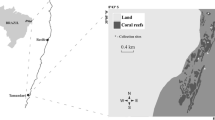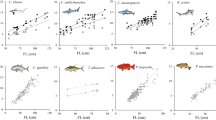Abstract
In fishes, a small body size may facilitate cost-effective exploitation of various primary and secondary food resources, but may pose difficulties associated with digestion of plant material and finding sufficient food in a foraging area potentially restricted by a high risk of predation. We examined the trophic ecology of five common, small-bodied coral reef fish from the family Gobiidae. For each species, we determined diet composition, feeding bite rate, foraging substrate, and feeding behaviour, and examined whether diet composition and feeding bite rate changed ontogenetically and seasonally. The five species showed a diverse range of trophic modes: Amblygobius bynoensis and Amblygobius phalaena were herbivores, Valenciennea muralis was a carnivore, Asterropteryx semipunctatus a detritivore, and Istigobius goldmanni an omnivore. Both the herbivores and detritivore supplemented their diet with animal material. The consumption of a wide range of dietary resources by the two smallest species with the most restricted mobility (A. semipunctatus and I. goldmanni) may ensure energy requirements are met within a restricted foraging area. There was a significant difference in mean feeding bite rate among species, with carnivore > herbivore > omnivore > detritivore. None of the species exhibited an ontogenetic shift in diet composition or increase in feeding bite rate, indicating that (1) postmaturation growth is not facilitated by a higher quality diet or increased feeding intensity following maturation, and (2) their small body size does not preclude herbivory. The herbivores had the highest gut:fish length ratio, which may facilitate plant digestion. While diet did not change seasonally, the mean feeding bite rate was significantly lower in winter than summer for four of the study species.




Similar content being viewed by others
References
Ackerman JL, Bellwood DR (2000) Reef fish assemblages: a re-evaluation using enclosed rotenone stations. Mar Ecol Prog Ser 206:227–237. doi:https://doi.org/10.3354/meps206227
Alexander RM (1996) Biophysical problems of small size in vertebrates. In: Miller PJ (ed) Miniature vertebrates: the implications of small body size. The Zoological Society of London, Oxford, pp 1–14
Alongi DM (1989) The role of soft-bottom benthic communities in tropical mangrove and coral reef ecosystems. Rev Aquat Sci 1:234–280
Bellwood DR (1988) Ontogenetic changes in the diet of early post-settlement Scarus species (Pisces: Scaridae). J Fish Biol 33:213–219. doi:https://doi.org/10.1111/j.1095-8649.1988.tb05464.x
Bowen SH, Lutz EV, Ahlgren MO (1995) Dietary protein and energy as determinants of food quality: trophic strategies compared. Ecology 76:899–907. doi:https://doi.org/10.2307/1939355
Choat JH, Clements KD (1998) Vertebrate herbivores in marine and terrestrial environments: a nutritional ecology perspective. Annu Rev Ecol Syst 29:375–403. doi:https://doi.org/10.1146/annurev.ecolsys.29.1.375
Choat JH, Clements KD, Robbins WD (2002) The trophic status of herbivorous fishes on coral reefs. I. Dietary analyses. Mar Biol (Berl) 140:613–623. doi:https://doi.org/10.1007/s00227-001-0715-3
Clarke KR, Warwick RM (1994) Change in marine communities: an approach to statistical analysis and interpretation. Natural Environment Research Council, UK
Clifton KE (1995) Asynchronous food availability on neighboring Caribbean coral reefs determines seasonal patterns of growth and reproduction for the herbivorous parrotfish Scarus iserti. Mar Ecol Prog Ser 116:39–46. doi:https://doi.org/10.3354/meps116039
Crossman DJ, Choat JH, Clements KD, Hardy T, McConochie J (2001) Detritus as food for grazing fishes on coral reefs. Limnol Oceanogr 46:1596–1605
Cummins K, Wuycheck J (1971) Caloric equivalents for investigations in ecological energetics. International Association of Theoretical and Applied Limnology, Stuttgart
Depczynski M, Bellwood DR (2003) The role of cryptobenthic reef fishes in coral reef trophodynamics. Mar Ecol Prog Ser 256:183–191. doi:https://doi.org/10.3354/meps256183
Feller RJ, Warwick RM (1988) Energetics. In: Higgins RP, Thiel H (eds) Introduction to the study of meiofauna. Smithsonian Institute Press, Washington, pp 181–196
Gladfelter WB, Johnson WS (1983) Feeding niche separation in a guild of tropical reef fishes (Holocentridae). Ecology 64:552–563. doi:https://doi.org/10.2307/1939975
Harrison IJ (1996) Interface areas in small fish. In: Miller PJ (ed) Miniature vertebrates: the implications of small body size. The Zoological Society of London, Oxford, pp 15–45
Hart PJB (1997) Foraging tactics. In: Godin JJ (ed) Behavioural ecology of teleost fishes. Oxford University Press, Oxford, pp 104–133
Hellawell JM, Abel R (1971) A rapid volumetric method for the analysis of the food of fishes. J Fish Biol 3:29–37. doi:https://doi.org/10.1111/j.1095-8649.1971.tb05903.x
Hernaman V (2003) A comparative analysis of the life history and ecology of five species of coral reef goby (Teleostei: Gobiidae). Ph.D thesis. Department of Marine Science, Dunedin
Hernaman V, Munday P (2005a) Life-history characteristics of coral reef gobies. II. Mortality rate, mating system and timing of maturation. Mar Ecol Prog Ser 290:223–237. doi:https://doi.org/10.3354/meps290223
Hernaman V, Munday PL (2005b) Life-history characteristics of coral reef gobies. I. Growth and life-span. Mar Ecol Prog Ser 290:207–221. doi:https://doi.org/10.3354/meps290207
Hernaman V, Munday PL (2007) Evolution of mating systems in coral reef gobies and constraints on mating system plasticity. Coral Reefs 26:585–595. doi:https://doi.org/10.1007/s00338-007-0222-1
Hoese DF, Larson HK (1994) Revision of the Indo-Pacific gobiid fish genus Valenciennea, with descriptions of seven new species. Bishop Museum Press, Honolulu
Huh SH, Kitting CL (1985) Trophic relationships among concentrated populations of small fishes in seagrass meadows. J Exp Mar Biol Ecol 92:29–43. doi:https://doi.org/10.1016/0022-0981(85)90020-6
Kotrschal K, Thomson DA (1986) Feeding patterns in eastern tropical Pacific blennioid fishes (Teleostei: Tripterygiidae, Labrisomidae, Chaenopsidae, Blenniidae). Oecologia 70:367–378. doi:https://doi.org/10.1007/BF00379499
Kritzer JP (2002) Stock structure, mortality and growth of the decorated goby, Istigobius decoratus (Gobiidae), at Lizard Island. Great Barrier Reef Environ Biol Fish 63:211–216. doi:https://doi.org/10.1023/A:1014278319097
MacNeill DB, Brandt SB (1990) Ontogenetic shift in gill raker morphology and predicted prey capture efficiency of the alewife Alosa psuedoharengus. Copeia 1990:164–171. doi:https://doi.org/10.2307/1445832
Manica A (2002) Filial cannibalism in teleost fish. Biol Rev Camb Philos Soc 77:261–277. doi:https://doi.org/10.1017/S1464793101005905
McCormick MI (1998) Ontogeny of diet shifts by a microcarnivorous fish, Cheilodactylus spectabilis: relationship between feeding mechanics, microhabitat selection and growth. Mar Biol (Berl) 132:9–20. doi:https://doi.org/10.1007/s002270050367
Miller PJ (1979) Adaptiveness and implications of small size in teleosts. Symp Zoo Soc Lond 44:263–306
Miller PJ (1996) The functional ecology of small fish: some opportunities and consequences. In: Miller PJ (ed) Miniature vertebrates: the implications of small body size. The Zoological Society of London, Oxford, pp 175–199
Munday PL, Jones GP (1998) The ecological implications of small body size among coral-reef fishes. Oceanogr Marine Biol annu rev 36:373–411
Munday PL, Wilson SK (1997) Comparative efficacy of clove oil and other chemicals in anaesthetization of Pomacentrus amboinensis, a coral reef fish. J Fish Biol 51:931–938
Overholtzer KL, Motta PJ (1999) Comparative resource use by juvenile parrotfishes in the Florida keys. Mar Ecol Prog Ser 177:177–187. doi:https://doi.org/10.3354/meps177177
Payne AG, Smith C, Campbell AC (2002) Filial cannibalism improves survival and development of beaugregory damselfish embryos. P R Soc Lond B Biol 269:2095–2102. doi:https://doi.org/10.1098/rspb.2002.2144
Purcell SW, Bellwood DR (1993) A functional analysis of food procurement in two surgeonfish species, Acanthurus nigrofuscus and Ctenochaetus striatus (Acanthuridae). Environ Biol Fishes 37:139–159. doi:https://doi.org/10.1007/BF00000589
Thomassin B (1978) Soft-bottom communities. In: Stoddart DR, Johannes RE (eds) Coral reefs: research methods. UNESCO monographs on oceanographic methodology vol 5, Paris, pp 263–298
Thomassin BA, Jouin C, Renaud-Mornant J, Richard G, Salvat B (1982) Macrofauna and meiofauna in the coral sediments on the tiahura reef complex, Moorea Island (French Polynesia). Tethys 10:392–397
Townsend KA, Tibbetts IR (2004) The ecological significance of the combtoothed blenny in a coral reef ecosystem. J Fish Biol 65:77–90. doi:https://doi.org/10.1111/j.0022-1112.2004.00426.x
Wilson S (2002) Nutritional value of detritus and algae in blenny territories on the Great Barrier Reef. J Exp Mar Biol Ecol 271:155–169. doi:https://doi.org/10.1016/S0022-0981(02)00035-7
Wilson S, Bellwood DR (1997) Cryptic dietary components of territorial damselfishes (Pomacentridae: Labroidei). Mar Ecol Prog Ser 153:299–310. doi:https://doi.org/10.3354/meps153299
Wilson SK, Burns K, Codi S (2001) Sources of dietary lipids in the coral reef blenny Salarias patzneri. Mar Ecol Prog Ser 222:291–296. doi:https://doi.org/10.3354/meps222291
Wilson SK, Bellwood DR, Choat JH, Furnas MJ (2003) Detritus in the epilithic algal matrix and its use by coral reef fishes. Oceanogr Mar Biol 41:279–309
Wootton RJ (1998) Ecology of teleost fishes. Kluwer, Dordrecht
Zeller DC (1986) Mobile invertebrate fauna associated with algal turfs: a field exeriment investigating the effects of exclusion of fishes and territorial behaviour of stegastes apicalis (Pomacentridae). BSc thesis, Marine Biology Department, Townsville
Acknowledgments
We thank J. H. Choat for providing substantial logistical support at James Cook University, J. Vasques and P. Brewin for field assistance, and the staff at the Orpheus Island Research Station. We also thank two anonymous reviewers for constructive comments on the manuscript. This study was funded by a University of Otago Research Grant awarded to P.K.P., and a Commonwealth Postgraduate Scholarship and PADI Aware Research Grant awarded to V.H. The experiments in this study comply with the current Australian laws.
Author information
Authors and Affiliations
Corresponding author
Additional information
Communicated by U. Sommer.
Rights and permissions
About this article
Cite this article
Hernaman, V., Probert, P.K. & Robbins, W.D. Trophic ecology of coral reef gobies: interspecific, ontogenetic, and seasonal comparison of diet and feeding intensity. Mar Biol 156, 317–330 (2009). https://doi.org/10.1007/s00227-008-1085-x
Received:
Accepted:
Published:
Issue Date:
DOI: https://doi.org/10.1007/s00227-008-1085-x




